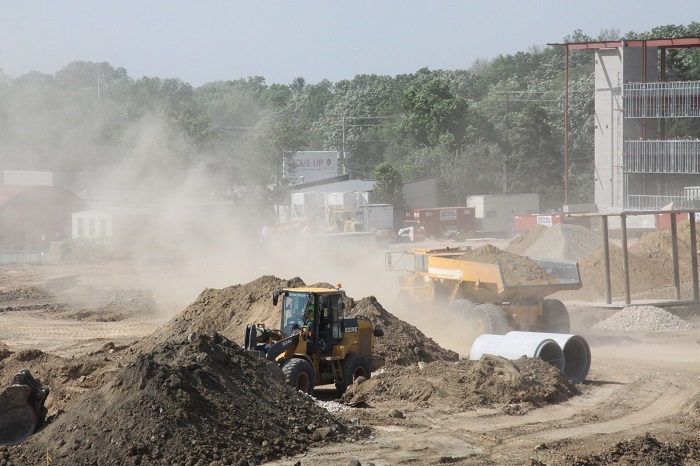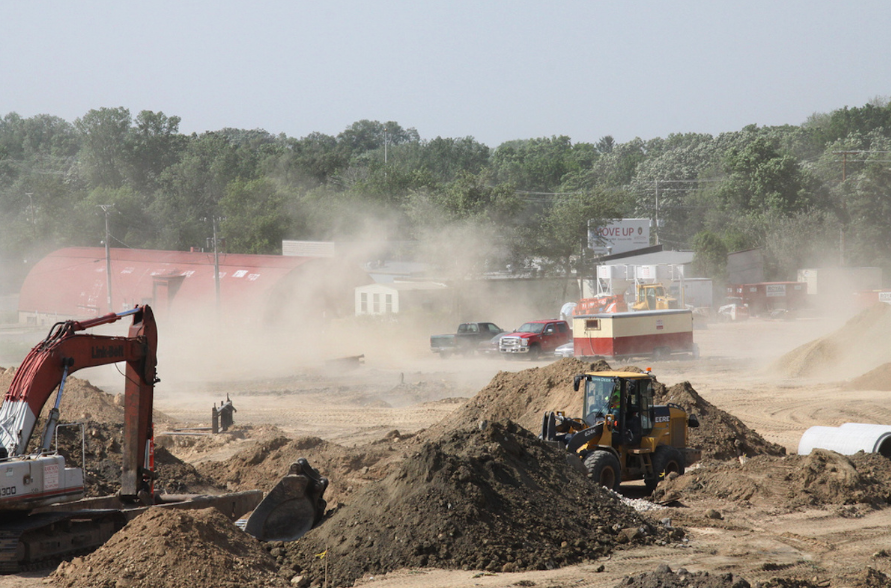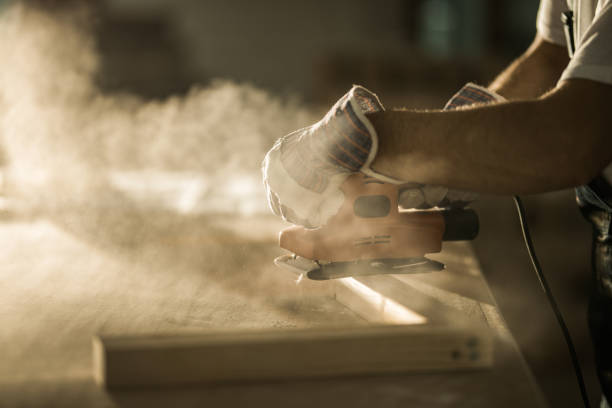Have you ever found yourself coughing incessantly while working on construction projects? You could be breathing in dangerous amounts of construction dust, and even when you leave the site, you could bring home that dust and unintentionally have your family members breathe in these toxic chemicals. To combat all the dust that surfaces at the job site, consider renting a water truck, to help decrease the amount of construction dust you’re bound to cause due to cutting, drilling, and sandblasting.
Types of Construction Dust
Construction dust is a generic term for natural minerals or human-made mineral fibers that occur when completing certain construction tasks. There are three types of construction dust:
- Silica dust: A natural mineral, silica exists in common construction materials, including cement, concrete, and mortar. Silica dust occurs once the material undergoes a significant change, such as cutting, drilling, grinding, and sandblasting materials like granite, sand, and sandstone. It’s also known as respirable crystalline silica (RCS). This is the most dangerous type of construction dust.
- Non-silica dust: Some construction projects don’t have silica present or have silica in minimal amounts, thus resulting in lower toxicity. The material where this type of dust is present includes cement, dolomite, gypsum (plasterboard), limestone, and marble. You tend to find non-silica dust when cutting bricks. Non-silica dust is still harmful to human health, so you should still ensure that you adhere to safety measures.
- Wood dust: This type of dust surfaces when you work mainly on hardwood and softwood. Other wood-based products include chipboard, MDF, and plywood. Carpenters are at the highest risk for wood dust inhalation.
Hazards of Construction Dust for Workers

Fine dust particles are dangerous, especially if they’re silica dust particles. Once inhaled, the dust can reduce your lung capacity, increase the overall strain on your heart, and cause a variety of diseases. You may also experience irritation in your eyes, nose, throat, skin, and lungs. At first, you may think you’re dealing with allergies or a mild cold, but over time, these symptoms can increase. Dust can also cause or exacerbate asthma.
The most serious long-term issue involves the respiratory system. Even if your nose and lungs can catch some of the irritants, once they settle in the deepest recesses of your lungs, they can damage the surrounding tissue. Once the buildup of scar tissue occurs, it can cause difficulty in breathing and may cause you to develop lung cancer or chronic obstructive pulmonary disorder (COPD). Although some diseases come on quickly, most take a long time. If you don’t catch the damage early on, it becomes more difficult to treat.
According to the U.S. Department of Labor’s Occupational Safety and Health Administration (OSHA), about 2.3 million workers receive exposure to crystalline silica in the workplace. This number includes 2 million construction workers.

To combat this, the organization issued a rule on silica dust exposure, effective September 2017, with the overall goal to curb lung disease, COPD, and silicosis. One of the key provisions is to reduce the permissible exposure limit (PEL) for RCS to 50 micrograms per cubic meter of air over an eight-hour time frame. The previous PEL was 100 micrograms per cubic meter. OSHA estimates that these reductions will save more than 600 lives and prevent more than 900 new cases of silicosis from occurring annually.
OSHA established the PEL to create a legal limit for worker exposure to silica. To determine the PEL, you must consider air, dust, and time. For air, you take into account that larger people have larger lungs and can breathe more air. Similarly, someone who’s physically fit breathes less air compared to someone who is out of shape. For dust, it depends upon the type of material, the size of the piece being cut, and how much material was removed. For air, you consider the amount of time that you breathed the air and dust.
Not only is construction dust dangerous to you, but you could inadvertently bring the dust home on your work attire and expose your family members. To combat this, you should change into washable work clothes at the construction site, and once you’re done for the day, shower and change into clean clothes. You should also consider parking your vehicle away from any construction when you’re at the job site.
Hazards of Construction Dust on Equipment

Not only is construction dust detrimental to you as a worker, but it wreaks havoc on construction equipment. Once your pieces of equipment take on significant amounts of dust, you must maintain the equipment more frequently due to engine wear. As a result, overall operating costs rise.
Construction dust is abrasive and can cause considerable damage to equipment when exposed. If the engine comes into contact with the dust, you may experience engine failure, particularly if it’s a gasoline-powered piece of equipment. Often, the concrete dust gets past the air filter system and encounters the engine cylinder, causing wear and tear on the piston and cylinder. Starter ropes and starter assemblies also experience wear due to dust.
Even if the air filter can keep most of the dust-out, you need to continually clean the filter. Other types of equipment, such as powered drills, also feel the effects of dust, since it sticks to greased surfaces. When that happens, the dust acts as a paste, making the pieces of equipment stick and wear faster. Similarly, if the machine gets wet and has dust buildup, the dust can harden, since it’s made of concrete. You could experience trouble with the equipment’s nuts and bolts.
Protecting the Workers at the Construction Site
To combat the effects of construction dust on workers, as previously mentioned, OSHA issued a rule in 2017 to tighten the exposure limit. In addition to these measures, you can become proactive and protect yourself individually by using personal protective equipment (PPE), including respirators and dust masks.
The National Institute for Occupational Safety and Health (NIOSH) has approved filtering respirators or dust masks to provide extra breathing protection from dust. Those marked N100/R100/P100 protect you against dust levels up to 10 times the exposure limit. You should make sure the mask fits tightly, so the only air you breathe is filtered. However, the masks do not work well for large amounts of dust. Also, you should replace these masks daily, if you have difficulty breathing, or if the inside of the mask becomes dirty.
Another option to consider is an air-purifying respirator. Although these deal more with gas and vapor, they can protect you from construction dust. The respirator comes with a statement of certification, which signifies what you should use the respirator for and how it can protect you.
If your work involves being outside, you also need to wear a mask. While the wind has some effect on the dust level created, you may partake in tasks that have you working close to the tools that create the dust. As a result, you can still breathe in quite a bit of harmful dust.
Construction Dust Control at a Job Site
Several options are available to minimize construction dust at your job site. You can check with OSHA on how to contain and suppress dust at the site. One of the best and most inexpensive ways to cut down on dust is to spray the area down with water. For outdoor projects, depending on the weather and the location of the project, you should water the area at least three times per day. Water trucks can help the dirt and dust stay down. Make sure not to overwater the area, as that can cause erosion and runoff.
Laying down mulch and vegetation is another option, as it controls dust and erosion. After you water the area to get it established, you don’t need to tend to it. Tackifiers also create bonds with seeds and keep them from blowing away. Polymers are another resource that you apply on soil and then spray with water trucks.
With indoor projects, you should always try to barricade off the area or tape down areas to prevent dust from accumulating. Use dust-abatement technology to keep dust levels down, as well as wet saws and dust collectors to keep harmful levels of dust away.
Negative-air HEPA filter vacuums offer inward airflow to help prevent dust and other particulates from escaping into the work area. Afterward, air scrubbers capture the contaminated air and then clean it and filter it back into the area. Avoid using a broom, as this can cause the dust to remain in the air. Daily cleanups are a must to keep the dust from escaping the area.
Conclusion
Construction dust is harmful to anyone working at a job site. As well as family members who can inhale toxins if you bring dust home on your clothes or your body. Selecting the right water truck can help you minimize the effect of construction dust.
You might feel overwhelmed when deciding which water truck you should use. Contact the water truck experts, and they can help you make the best choice for your needs.
